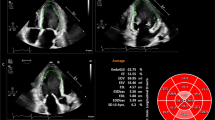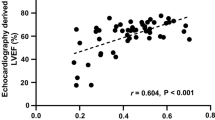Abstract
Purpose
The purpose of this study was to test whether the fractional change in the endocardial border length between end-diastole and end-systole as manually traced in left ventricular ejection fraction (LVEF) measurement using the biplane method of disks (MOD) was consistent with the global longitudinal strain derived from speckle-tracking echocardiography.
Methods
For 105 patients who underwent echocardiography, two- and four-chamber images with manually traced endocardial lines for LVEF measurement by MOD were stored. LV endocardial lengths at end-diastole and at end-systole were measured on both images to calculate the fractional length changes, which were averaged (GLSMOD). Speckle-tracking analysis was performed to measure global longitudinal strains in the apical two- and four-chamber and long-axis images, and the three values were averaged (GLSSTE) according to the ASE and EACVI guidelines.
Results
There was no significant difference between GLSMOD and GLSSTE. GLSMOD correlated well with GLSSTE (r = 0.81, p < 0.001), and there was no fixed bias in the Bland–Altman analysis. The intraclass correlations for the intra- and inter-observer comparisons for GLSSTE were excellent, and those for GLSMOD were adequate.
Conclusion
The fractional LV endocardial border length change, GLSMOD, showed sufficient agreement with GLSSTE to justify its use as a substitute for the STE-derived global longitudinal strain.



Similar content being viewed by others
References
Bohs LN, Trahey GE. A novel method for angle independent ultrasonic imaging of blood flow and tissue motion. IEEE Trans Biomed Eng. 1991;38:280–6.
Leitman M, Lysyansky P, Sidenko S, et al. Two-dimensional strain: a novel software for real-time quantitative echocardiographic assessment of myocardial function. J Am Soc Echocardiogr. 2004;17:1021–9.
Langeland S, D’hooge J, Wouters PF, et al. Experimental validation of a new ultrasound method for the simultaneous assessment of radial and longitudinal myocardial deformation independent of insonation angle. Circulation. 2005;112:2157–62.
Collier P, Phelan D, Klein A. A test in context: myocardial strain measured by speckle-tracking echocardiography. J Am Coll Cardiol. 2017;69:1043–56.
Lang RM, Badano LP, Mor-Avi V, et al. Recommendations for cardiac chamber quantification by echocardiography in adults: an update from the American Society of Echocardiography and the European Association of Cardiovascular Imaging. J Am Soc Echocardiogr. 2015;28:1–39.
Klaeboe LG, Edvardsen T. Echocardiographic assessment of left ventricular systolic function. J Echocardiogr. 2019;17:10–6.
Voigt JU, Pedrizzetti G, Lysyansky P, et al. Definitions for a common standard for 2D speckle tracking echocardiography: consensus document of the EACVI/ASE/Industry Task Force to standardize deformation imaging. J Am Soc Echocardiogr. 2015;28:183–93.
Tabata T, Grimm RA, Greenberg NL, et al. Assessment of LV systolic function in atrial fibrillation using an index of preceding cardiac cycles. Am J Physiol Heart Circ Physiol. 2001;281:H573–80.
Kalam K, Otahal P, Marwick TH. Prognostic implications of global LV dysfunction: a systematic review and meta-analysis of global longitudinal strain and ejection fraction. Heart. 2014;100:1673–80.
Yang H, Negishi K, Wang Y, et al. Echocardiographic screening for non-ischaemic stage B heart failure in the community. Eur J Heart Fail. 2016;18:1331–9.
Fries B, Liu D, Gaudron P, et al. Role of global longitudinal strain in the prediction of outcome in patients with severe aortic valve stenosis. Am J Cardiol. 2017;120:640–7.
Laufer-Perl M, Derakhshesh M, Milwidsky A, et al. Usefulness of global longitudinal strain for early identification of subclinical left ventricular dysfunction in patients with active cancer. Am J Cardiol. 2018;122:1784–9.
Feigenbaum H, Mastouri R, Sawada S. A practical approach to using strain echocardiography to evaluate the left ventricle. Circ J. 2012;76:1550–5.
Stanton T, Leano R, Marwick TH. Prediction of all-cause mortality from global longitudinal speckle strain comparison with ejection fraction and wall motion scoring. Circ Cardiovasc Imaging. 2009;2:356–64.
Kobayashi Y, Ariyama M, Kobayashi Y, et al. Comparison of left ventricular manual versus automated derived longitudinal strain: implications for clinical practice and research. Int J Cardiovasc Imaging. 2016;32:429–37.
Medvedofsky D, Kebed K, Laffin L, et al. Reproducibility and experience dependence of echocardiographic indices of left ventricular function: side-by-side comparison of global longitudinal strain and ejection fraction. Echocardiography. 2017;34:365–70.
Farsalinos KE, Daraban AM, Ünlü S, et al. Head-to-head comparison of global longitudinal strain measurements among nine different vendors: the EACVI/ASE inter-vendor comparison study. J Am Soc Echocardiogr. 2015;28:1171–81.
Thavendiranathan P, Negishi T, Coté MA, et al. Single versus standard multiview assessment of global longitudinal strain for the diagnosis of cardiotoxicity during cancer therapy. JACC Cardiovasc Imaging. 2018;11:1109–18.
Author information
Authors and Affiliations
Corresponding author
Ethics declarations
Conflict of interest
This study was financially supported by a grant-in-aid for scientific research from the Japanese Society of Sonographers (No. 2017-1). The authors declare no other conflicts of interest.
Ethical approval
This study was approved as a retrospective observational study by the Research Ethics Committee of the Faculty of Health Sciences at Hokkaido University. Instead of obtaining informed consent, the objectives and methods of the present study were shared with the public through our institution’s website and a physical bulletin board; patients who did not wish to participate could request their data to be deleted from the study.
Additional information
Publisher's Note
Springer Nature remains neutral with regard to jurisdictional claims in published maps and institutional affiliations.
About this article
Cite this article
Okada, K., Kaga, S., Araki, M. et al. Left ventricular global longitudinal strain calculated from manually traced endocardial border lengths utilizing the images for routine ejection fraction measurement by biplane method of disks. J Med Ultrasonics 47, 91–96 (2020). https://doi.org/10.1007/s10396-019-00976-w
Received:
Accepted:
Published:
Issue Date:
DOI: https://doi.org/10.1007/s10396-019-00976-w




